All our fantasy baseball rankings for 2023 can be found inside our Draft Kit. Sign up to PL Pro to access all our 2023 player projections with our auction draft calculator.
Before we get started, I’ll briefly review my basic assumptions and philosophy:
These rankings assume a 5×5 head-to-head categories format with one catcher, one first baseman, one second baseman, one shortstop, one third baseman, three outfielders, two utility hitters, a shallow bench, and at least two IL spots. I am also assigning eligibility based on five starts at the position, so don’t be entirely shocked if your host site doesn’t list some of these guys at each position I list below. The scoring categories for hitters that I’m basing these rankings on are runs scored, home runs, runs batted in, stolen bases, and batting average.
Unlike deeper formats with an overall component like the NFBC, standard head-to-head leagues don’t put much of a premium on stolen bases. Additionally, the relatively high replacement level at most positions suppresses the value of players with high floors but low ceilings (like Jean Segura), so as we get to the later part of the rankings you’ll see that I value upside quite a bit more than safety.
There are leagues of all shapes and sizes out there, and I can’t possibly accommodate all of them in a single set of rankings. Don’t hesitate to reach out in the comments if you want to know whether a setting or situation would dramatically change a ranking, but in general, players won’t slide up or down more than one or two tiers (most will move even less) unless it’s an extreme or highly unusual scenario.
With that out of the way, let’s dive into the rankings!
Tier 1
1. Freddie Freeman (LAD), 1B
The 21 home runs were a bit disappointing, but Freeman still finished as fantasy’s second-best first baseman thanks to 117 runs scored, 100 RBI, 13 stolen bases, and an amazing .325 batting average, giving him positive contributions in all five categories. Freeman has now finished as a top-two first baseman for five straight seasons, and that’s why he sits on top of these rankings.
Freeman should be locked into the two-hole in the lineup for the Dodgers, giving him ample opportunity to once again put up at 100 runs and 100 RBI hitting behind Mookie Betts and in front of Will Smith, though it’s safe to say that the heart of the Dodger batting order isn’t quite as fearsome in years past (unless Max Muncy and J.D. Martinez look a bit more like their old selves). Freeman’s stolen bases should be quite safe as well, as he’s a savvy veteran with just enough speed to make it happen. Additionally, with the lineup being a little more toothless than in years past, there may be more incentive for Freeman to run, especially with the loss of former leadoff man Trea Turner to the Phillies.
That just leaves a question about the power, and to be honest, I can’t really see anything in Freeman’s Statcast or traditional data that explains why he put up the lowest full-season home run total since 2018. While his high-water mark of 38 in 2019 is likely to remain a career-high, Freeman hits the ball hard enough and with enough lift to hit more like 25-28 home runs as opposed to the low 20s, and there’s nothing about Dodger Stadium that would potentially dampen his power profile.
I’m chalking it up as a bit of bad luck in the fly ball department, and with a return to 25 or more home runs, Freeman should have no issue extending his streak of top-two performances at first base to six.
2. Vladimir Guerrero Jr. (TOR), 1B
The groundball issue that capped Vladito’s home runs disappeared in 2021, leading to a monstrous 48-home run season that propelled him to a top finish at first base. Unfortunately, those grounders returned in 2022, “limiting” his home run production to 32 as he fell short of both 100 runs scored and 100 RBI, though he did manage to steal eight bases and hit .274 even with the ball on the ground 52.1% of the time.
As you can see from the chart below, there’s a pretty strong correlation between how often Guerrero Jr. makes contact on pitches outside the zone and how often he puts the ball on the ground, which certainly makes sense—balls outside of the zone are difficult to square up and difficult to send out of the park, so the more he connects with them, the more likely he is to make less-than-ideal contact:
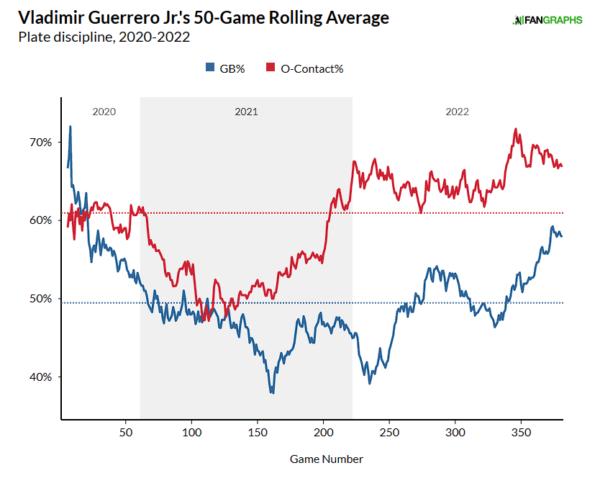
Our metrics also somewhat point to this problem, as his decision value took a nosedive in the second half of the season, and based on his corresponding swing aggression, it’s likely due to Vlad swinging at pitches he likely shouldn’t have:
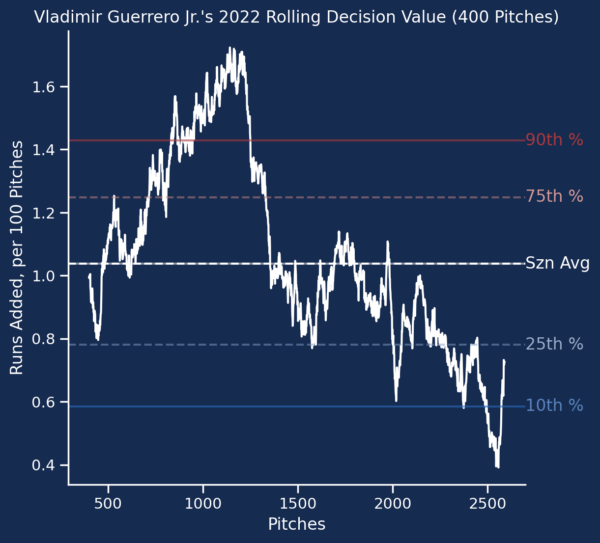
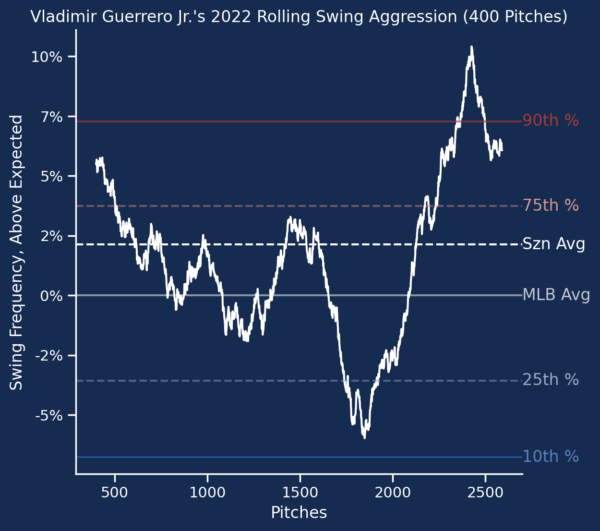
The good news is that Vlad has fixed this issue before by simply making better decisions—even when he’s more aggressive than average. By exercising just a little patience on the edges in 2023, he can return to the top of first base thanks to his chip-in speed and excellent batting average in a powerful Toronto lineup.
I actually don’t mind grabbing Vlad Jr. ahead of Freeman if you believe he’s likely to cure the groundball issue over the offseason, as his ceiling is a bit higher than Freddie’s, but I chose to rank Freeman ahead of Vlad due to Freeman’s unbelievable floor.
Tier 2
3. Pete Alonso (NYM), 1B
The Polar Bear is coming off a 40-home run season where he drove in a whopping 131 runners while hitting .271/.352/.518 and posted his second consecutive sub-20% strikeout rate. In other words, he’s doing everything we’ve wanted the slugger to do since he exploded onto the scene in 2019 and then some.
Heading into his age-28 season, you’re not really asking Alonso do to more than what he did in 2023—you’re just asking Alonso to do it again. While he isn’t likely to steal more than five bases, Alonso does an excellent job putting the ball in the air and pulling it for power, and in four major league seasons, Alonso has never missed more than nine games. You can bank on something like a .260 to .270 average and another 40 home runs or so, and with the Mets’ top three hitters returning to the lineup in 2023, he’s one of the very few players who you can feel good about getting to 110 RBI. In fact, despite having 22 fewer home runs than Aaron Judge, Alonso tied him for the league lead in runners batted in.
Some might prefer Goldschmidt due to Goldie’s base-stealing ability (though he’ll need a boost from the rule changes to get to double-digits again), but in formats like head-to-head categories where stolen bases don’t carry quite as much weight, I’m more than happy to take the higher power and RBI ceilings that Alonso brings to the table.
4. Paul Goldschmidt (STL), 1B
Despite being 34 years old in 2022, Goldschmidt showed little sign of slowing down. The reigning National League MVP put up the best season of his career by wRC+ and fWAR thanks to a .317/.404/.578 line, 35 home runs, seven stolen bases, and 221 combined runs and RBI batting in the heart of the St. Louis batting order.
There aren’t many questions about what Goldschmidt can do—he has at least 30 home runs in every full season since 2017, and in nine of the last ten seasons, Goldschmidt has batted at least .290. While once a stolen base threat, age has caught up to him a little in this department, stealing just seven bases in 2022 and just four combined in 2020 and 2021. The rule changes impacting pick-off moves and the size of the base might give Goldschmidt some of those stolen bases back, but it’s something that’s difficult to predict heading into the season.
If you’re in an OBP league or if you already drafted a guy like Aaron Judge in the first round for power or if you took perhaps more of a batting average risk like Bobby Witt Jr. and you’re deciding between Alonso or Goldschmidt, I have no issues going after Goldschmidt over Alonso to chase what might be a spike in stolen bases and locking in improved ratios. I prefer going for Alonso’s power, but I consider this a true toss-up.
5. Matt Olson (ATL), 1B
Matt Olson should definitely go a little later than the two guys ahead of him in this tier, but his floor and ceiling are just too strong to say he’s truly a tier below the other two. He has no fewer than 34 home runs in each of the last three full seasons, and now that he’s in Atlanta, 100 RBI should be no problem if he hits 30 home runs.
While the floor and ceiling are strong, his batting average does present real risk—he finished 2022 with just a .240 batting average, and the strikeout rate crept back up towards 25% after Olson had brought it down to 16.8% in 2021. That’s not a bad thing, necessarily, but it does cap his ceiling a bit compared to the players above him. That should make Olson available about two rounds later than the other two, and if you’re looking to secure the last of the “sure thing” first baseman, you’d do well to target Olson.
Tier 3
6. Nathaniel Lowe (TEX), 1B
Lowe took big steps forward as a hitter in 2022, hitting 27 home runs with a .302/.345/.492 line, good for a 143 wRC+. The left-handed slugger hits both lefties and righties well above average (.817 OPS against righties and a .920 OPS against lefties in 2022) with power to all fields. While not a fast runner, Lowe possesses average speed and swiped eight bases back in 2021, which provides a glimmer of hope that there might be double-digit steals in his future with the rule changes coming in 2023.
Some projection systems want to split the difference between his 18 home runs in 2021 and his 27 last season, but I’m of the belief that Lowe can continue to hit 25 or more home runs by continuing to keep that groundball rate below 50% and perhaps even pulling a few more fly balls. Lowe slugged about 150 points higher on fly balls in 2022 compared to 2021 by more than doubling the number of fly balls he pulled (12 in 2021, 26 in 2022), which added nine home runs to his total.
I feel much better when I’m asking a player to continue doing what they did as opposed to asking them to change something when it comes to projecting for the following season, and while Lowe trended down slightly in both fly ball and pull rate as 2022 wore on, he was still markedly better for all of 2022 than he was in years past, giving me confidence that he can at least sustain this type of success, if not improve upon it in his age-27 season.
7. Vinnie Pasquantino (KCR), 1B
Let’s start with the good. There’s a lot to like about Vinnie P—he has that classic combination of strike zone judgment and contact ability that makes us fantasy folks drool. As you can see from the charts below, his 200-swing rolling contact ability never dipped below the 90th percentile, and his judgment of the zone improved as the season went on going from pretty good to near-elite.
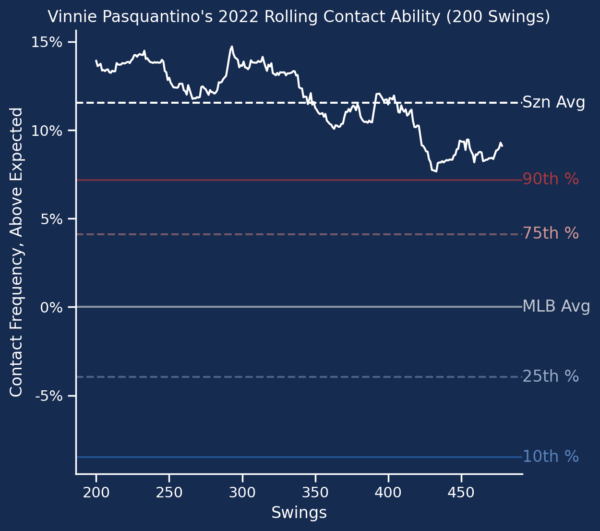
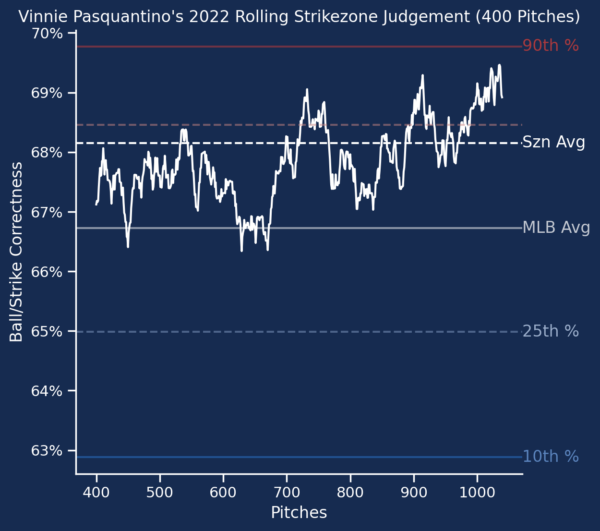
It’s got that Juan Soto feel to it in that you know Vinnie isn’t going to start chasing after pitches he can’t hit and he’s going to take every walk you give him. In points and OBP leagues, you might even consider bumping Pasquantino up to the top of this tier!
For those of us in more standard formats though, expectations should be tempered a bit due to some questions about how much power Vinnie P can bring at the big-league level. While he did hit 28 home runs between Triple-A and the major leagues, it was far more modest when Pasquantino found himself in Kansas City against big-league pitching and in a rather spacious home ballpark. While there’s 25-27 home run upside, a more reasonable expectation for his first full season in The Show is probably closer to 20 home runs. Piling up counting stats could also be an issue, though that’s more related to his supporting cast than Pasquantino’s own ability.
As I mentioned before, there’s a lot to love about Vinnie P’s profile, but remember not to let that elite plate discipline and contact ability cloud your judgment and overlook some potential limitations for Pasquantino in 2023.
8. Rhys Hoskins (PHI), 1B
Heading into his age-30 season, what you see is what you get with Rhys Hoskins. 30 home runs, a .246 batting average (oddly specific, but in the last four full seasons he’s hit .246, .245, .247, and .246), and roughly 80-90 RBI, though he could get a few more this season with Trea Turner at the top of the Phillies’ batting order.
OBP league players can get a little more excited, as his double-digit walk rate keeps his OBP at .330 or better every season, but otherwise, don’t expect any surprises from Hoskins. That’s OK though—not every pick needs extreme upside. Some picks are all about the floor, and when you’re looking at the rest of first base—and especially the tiers after this one—that floor looks pretty darn appealing.
9. José Abreu (HOU), 1B
There’s a wide range of outcomes for Abreu in 2023, which is weird to say about a guy who, until 2022, was a paragon of consistency at first base. On one hand, Abreu couldn’t ask for a better landing spot in terms of supporting cast—Houston should again be one of the best offenses in the American League, and Abreu should find himself hitting around Alex Bregman, Yordan Alvarez, and Kyle Tucker. If he looks anything like he did prior to 2022, Abreu would be a lock for 100 RBI.
That’s sort of the rub, though, as the 2022 version of Abreu didn’t really resemble the pre-2022 versions. After hitting at least 30 home runs in four of the last five full seasons (and also hitting a whopping 19 in 60 games in 2020), Abreu’s power cratered as he hit just 15 home runs, which also dragged down his RBI total to 75—42 fewer than his 117 in 2021 and only 15 more than he had in 2020 despite playing in nearly 100 more games. The batting line was fine—.304/.378/.446—but fantasy managers could not help but be disappointed in the paltry counting stats.
There are two things working against Abreu that dampen my power expectations in 2023. First, Abreu didn’t pull fly balls with authority as he has in year past. Despite hitting the same number of pulled fly balls in 2022 as he had in 2021 (28), Abreu’s ISO (slugging minus batting average) was cut in half on those batted balls. Second, while the team context in Houston is great, Minute Maid park plays fairly neutral for right-handed power, and Abreu was coming from the second-best stadium for right-handed power in Chicago. If he wasn’t able to get the ball over the fences at Guaranteed Rate stadium, it’s hard to imagine how Abreu will rebound significantly in the power department at a tougher home ballpark.
There’s enough track record and underlying skills for Abreu to emerge as the best first baseman in this tier, but with the potential to fall short of 20 home runs for a second consecutive season, I’m not taking that gamble unless I already feel good about how many home runs I have on my roster.
10. Christian Walker (ARI), 1B
The team context and ballpark aren’t ideal, and he’s not likely to hit better than .250 or so, but if what you’re looking for is power then Christian Walker has got what you need. The batting average is up and down for Walker (.204 batting average in the first half, .285 in the second half) because he’s such an extreme pull hitter, though Walker’s 55.7% pull rate on grounders combined with the rule changes preventing shifts means that Walker might be one of the few right-handed batters who will benefit from the rule changes related to shifts, as he hit just .230 against the shift in 2022 and was shifted 282 times—good for 13th most among all right-handed batters.
Walker primarily specializes in pulling fly balls, and that’s a very good thing (see Brandon Drury’s blurb below for a table explaining why), and for Walker, it led to 26 of his 36 home runs in 2022. He hit .474 and slugged 1.860 on fly balls to the pull field compared to .251 and .849 on fly balls as a whole, and the more he yanks fly balls to left field, the more stable his power and ratios should be.
With Walker’s plate discipline and power, he’s a solid bet to clear 30 home runs and hit at least .240 or .250. That said, Walker has been a bit plagued by injuries and inconsistencies in years past, so it comes with a bit more risk than the players at the top of this tier, and his counting stat totals don’t quite have the floor or ceiling of players ranked above him due to the more volatile nature of Arizona’s young (but hopefully improving) lineup.
Tier 4
11. C.J. Cron (COL), 1B
Is it weird that I’d like Cron more if he wasn’t in Colorado? Like every other Rockies hitter, Cron suffers from extreme home/road splits. Cron is slashing .313/.381/.629 in 142 games at home with 41 home runs, 99 runs scored, and 143 RBI, but just .223/.305/.366 with 16 home runs, 50 runs scored, and 51 RBI on the road over 150 games. Yes, you read that right—he puts up less than half the counting stats on the road compared to at home and loses 90 points in batting average.
Thanks to his power and how well he plays in Coors, Cron should end the season with 27-30 home runs and a batting average somewhere around .260 or so, but for those in head-to-head formats, Cron is either helping you or hurting you, and almost never anything in-between.
I struggle to roster and manage players like this, as I prefer to use my bench to stream pitchers or my last outfield or utility spot rather than benching a guy I took in the first 10 or 11 rounds for half the season, but folks in roto leagues or folks who don’t mind the management, there’s value to be had in Cron. I just don’t find the juice to be worth the squeeze.
12. Anthony Rizzo (NYY), 1B
This ranking in part comes from the fact that Rizzo looks to be a big beneficiary of the rule changes to both the shift and stolen bases. The limitation on the shift should help Rizzo get a batting average a little closer to .250 or so instead of the .224 he hit in 2022, and the larger bases and limited pick-off moves could help him get close to double-digit steals for the first time since 2017. Even if neither rule provides a huge impact for Rizzo, there’s still value in his profile.
In his first full season as a Yankee, Rizzo went all out on fly balls. Rizzo hadn’t posted a 40% fly ball rate since 2016, but in 2022 he did that and then some, hitting 49.3% of balls in the air. He also managed to pull a lot of those fly balls, with his 61 pulled flies being the 11th-most in baseball and fourth-most among left-handed hitters. With Yankee Stadium being baseball’s sixth-friendliest ballpark for left-handed power, Rizzo seems to have found a strategy that will allow him to make a big offensive impact for at least a few more seasons.
A drop in fly ball rate back to his career norms would be pretty detrimental to Rizzo’s ceiling, and he missed at least 20 games for the second consecutive season, which isn’t exactly the trend I’m looking for in a 33-year-old first baseman, but if Rizzo can keep pulling fly balls, he looks to be a fantastic value in 2023 based on early ADP.
13. Ryan Mountcastle (BAL), 1B
While we knew the park changes at Camden Yards would hurt Mouncastle’s power, there’s no way we could have expected him to drop from 33 home runs in 2021 to 22 in 2022, especially when you consider that he improved his hard-hit rate, barrel rate, average exit velocity, and just about every expected stat under the sun.
Those gains in almost every underlying metric are what give me hope for Mountcastle in 2023—guys with a 15% barrel rate tend to hit for a lot more power than what we saw. The six other hitters who had a 15% barrel rate (barrels per batted ball event, in this case) and 350 batted ball events had at least 30 home runs each (Aaron Judge, Yordan Alvarez, Kyle Schwarber, Shohei Ohtani, and Austin Riley). Per Statcast’s expected home run metric, Mountcastle should have hit closer to 27 or 28 home runs, and even if that’s a bit rosy thanks to the new dimensions of his home park, I refuse to believe that Mountcastle is less than a 25-home run hitter.
Of course, the reality is that Mountcastle was quite short of 25 home runs in 2022, and combined with his pedestrian .250/.305/.423 batting line, drafting Mountcastle as your primary first baseman still requires a leap of faith.
14. Andrew Vaughn (CWS), 1B/OF
Another mostly full season, another season of Vaughn falling short of 20 home runs. While we did see improvements in his batting average (he hit .271 in 2022), the lack of power and counting stats has been rather disappointing from the third overall pick in the 2019 draft.
Perhaps the most frustrating of Vaughn’s underlying issues is how passive he is on pitches in the zone and how aggressive he is on pitches out of the zone. His 63.2% swing rate on pitches in the zone was the 18th-lowest among 130 qualified hitters last season, while his chase rate of 35.5% was the 34th-highest. Ideally, a player with Vaughn’s skillset would have those rankings flipped—Vaughn should be swinging at a lot of pitches in the zone and laying off the stuff out of the zone. This concept bears itself out in our PLV stats as well, as Vaughn really struggles to judge the zone, and as a result, tends to make worse-than-average decisions.
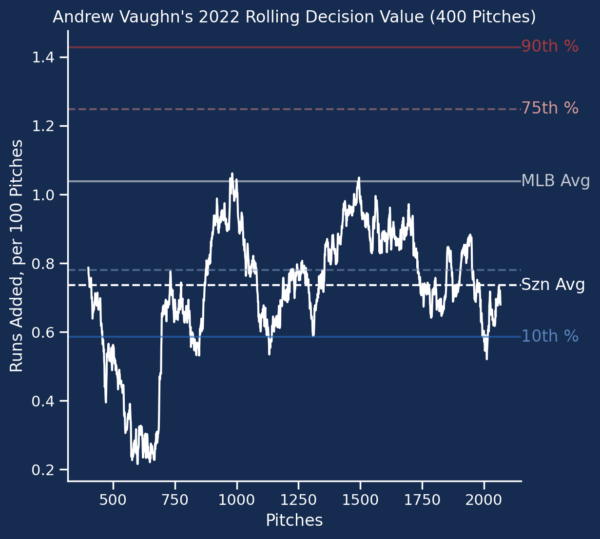
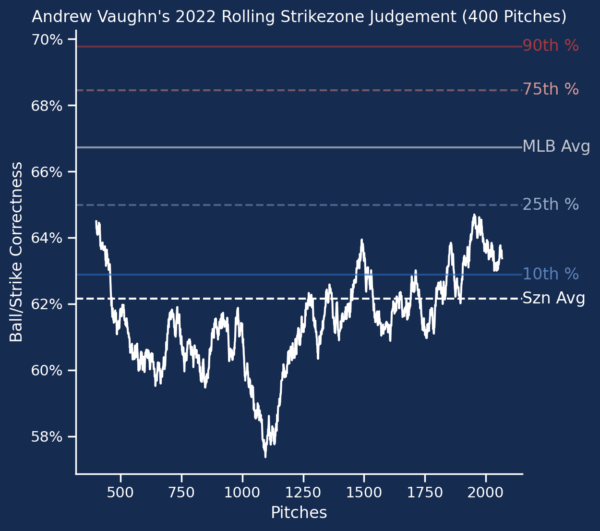
If there is any consolation, it’s that Vaughn DID improve his power output as 2022 went on, and since I dropped two sad charts above, I suppose I can end with a happy one:
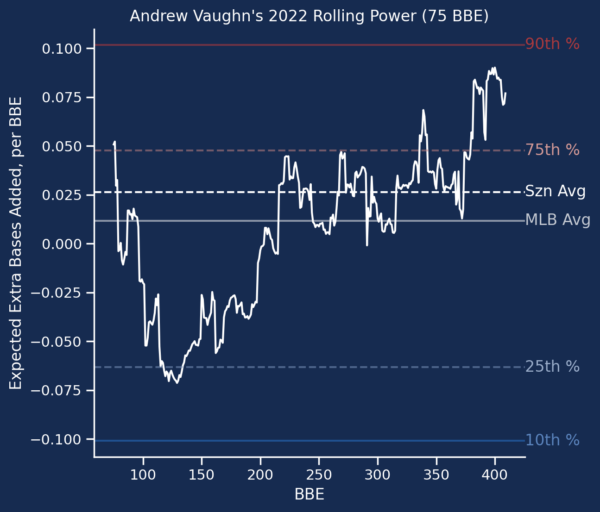
15. Ty France (SEA), 1B/3B
Batting in front of Eugenio Suárez is sort of the antithesis of Eugenio Suárez, and that’s Ty France. France’s 20 home runs in 2022 probably represent the realistic ceiling for his power production as he doesn’t hit the ball particularly hard nor does he barrel the ball particularly often. That being said, France makes plenty of contact (a career 17.7% strikeout rate) and hits plenty of line drives, which keeps his batting average north of .270.
While France isn’t as likely to go on soul-crushing slumps as Max Muncy or Eugenio Suárez, he also isn’t so likely to win you a weekly matchup practically by himself, either. France’s skill set is somewhat limited due to his complete lack of speed (he has two career attempts and he got caught both times) and limited power, so his only path to counting stats and fantasy prominence comes via accumulation—France needs to play a lot near the top of the lineup and he needs his teammates to get on base and drive him home because he can’t really do that stuff on his own very often.
That’s not necessarily a bad thing—baseball is a team sport, after all—but it does limit his upside in exchange for a safe floor. That could be valuable based on how your draft has gone up until this point, but if you missed out on the top tier and are trying to shoot for the moon, you’ll want to aim elsewhere. Instead, France makes sense for folks who took risks earlier in the draft, either performance risks like José Abreu or Adolis García, or health risks like Jazz Chisholm Jr. or Luis Robert.
16. Rowdy Tellez (MIL), 1B
In 2022, the 6’4, 255-pound southpaw did what big sluggers do best—mash home runs. His 35 home runs in his first full season as a Brewer resulted in large part due to that formula I’ve referred to so often in this article, and that’s pulled fly balls. While Rowdy didn’t exactly change how often he pulled the ball, his 45.5% groundball rate represents a significant spike from the 35-37% range he showed in years past, and his 49 pulled fly balls are more than he had in the three previous seasons combined. Rowdy hit .510 with a 2.327 OPS on those hits, and as long as he can keep them coming, he should continue to hit for plenty of power (albeit with a less-than-ideal batting average).
Rowdy took a bit of a step back against lefties, posting .209/.313/.644 line against them in 2022, but he’s shown the ability to hold his own against southpaws in the past, so any concerns about a platoon are likely premature given the Brewers’ lack of other options at first base (Keston Hiura doesn’t count, at least not yet).
17. Jose Miranda (MIN), 1B/3B
So you know all that stuff I just said about Ty France? Well, Miranda is basically that same exact trope—he won’t run, but he can make a lot of contact and hit a lot of line drives. While Miranda lacks France’s track record, he does have a little bit of a history when it comes to hitting home runs as he hit 30 home runs between Double-A and Triple-A in 2021. While few think he could provide that kind of juice here in the major leagues, Miranda shouldn’t have too much issue hitting 25 dingers, and unlike France, there might be possible universes where Miranda flirts with 25 home runs in a season.
While France’s floor is safer than Miranda’s in batting average and counting stats, Miranda’s potential for a bit more pop provides just enough intrigue that I might look his way instead if I’m not in dire need of more bankable stats.
Tier 5
18. Josh Bell (CLE), 1B
I was surprised to see that Bell actually hit grounders less frequently in 2022 than he had in 2020 and 2021, especially considering the rather significant drop in power, going from 27 home runs in 2021 to just 17 in 2022.
So what was the problem? What didn’t happen in San Diego that was happening in Washington? Yup, you guessed it—he didn’t pull those fly balls. Bell only hit four of his 39 fly balls as a Padre to the pull field, and as a result, he hit just .128 and slugged just .385 on balls in the air. As you can see from the chart below under Brandon Drury, that’s really, really bad.
Bell is headed to Cleveland now, and with any luck, he can find some of that pulled fly ball mojo, or even just ANY fly ball mojo. Bell had hit at least .281 and slugged at least .969 on fly balls in each of the three prior seasons, so perhaps the change of scenery can get Bell back to looking like a 25-home run hitter with strong on-base skills. He’s especially enticing in OBP leagues due to his high walk rate, which keeps his OBP north of .350 more often than it doesn’t, though his batting average should also be pretty decent (something like .260 or so).
19. Brandon Drury (LAA), 1B/2B/3B
I was admittedly surprised by how much Pitcher List’s own expected batting average (.248) and expected slugging (.477) supported what Drury did in 2022 compared to Baseball Savant’s numbers (.242 and .420, respectively). One of the primary differences between our expected stats and Savant’s expected stats is that we take direction into account while Savant does not.
In 2022, the league hit .222 and slugged .646 on fly balls. This makes sense, as fly balls that don’t clear the fences tend to land in a glove and not on the grass, and that means the expected stats for fly balls tend to be a bit sad. However, when it comes to fly balls, direction REALLY matters:
If you’re wondering how Brandon Drury found so much success in 2022 (and to a lesser extent, 2021), it’s from hitting and pulling more fly balls than ever before. His 22 home runs to the pull field ranked seventh in all of baseball, and Drury’s 52 pulled fly balls were the 14th most in baseball. While many will point to his time with the Reds and say Drury took advantage of Great American Ballpark (which he did), he’ll find the left field wall in Angel Stadium quite inviting—it’s only two feet further back than the one in Cincinnati, and the wall is several feet lower. In fact, Angel Stadium ranks seventh in home run factor for right-handed hitters, according to Statcast.
I’m not projecting Drury to hit 28 home runs again, but there’s evidence to suggest that he can hit 22-25 of them with a decent batting average if he can continue to pull fly balls. His positional flexibility only adds to his fantasy relevance, particularly with how shallow third base looks heading into 2023.
20. Triston Casas (BOS), 1B
This feels like a good time for a rolling chart, doesn’t it? Let’s look at some rolling charts:
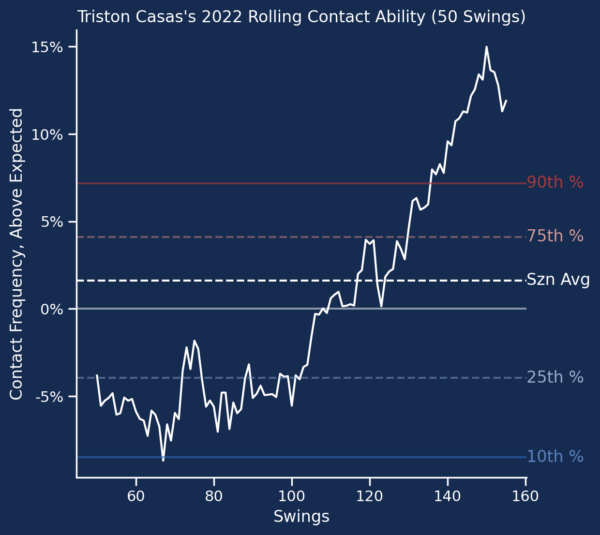
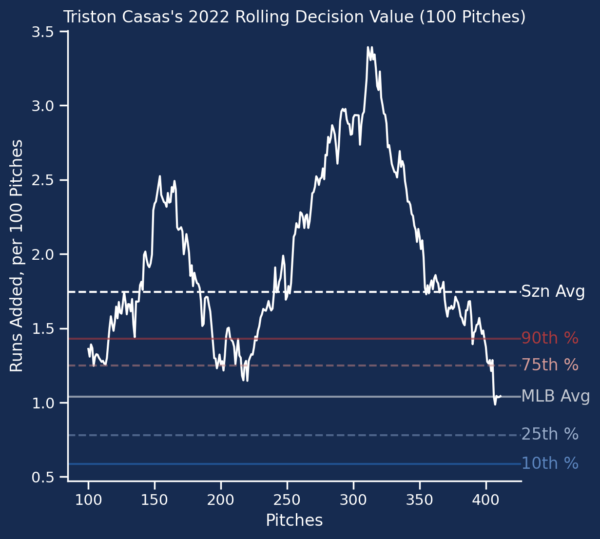
While we didn’t get a very long look at Casas in 2022, it’s extremely encouraging to see the young power hitter make extraordinary strides in his ability to make contact and show good (and sometimes ridiculously good) decisions at the plate. Casas’s calling cards in the minors were his plate discipline and hit tool with better-than-average power, and while we didn’t quite get enough of a power sample to make any meaningful conclusions, the underlying metrics suggest there are reasons for optimism as we head into 2023.
I’m not bold enough to take Casas as my starting first baseman, but if I’ve got the room on my roster for a second first baseman late in the draft and I want to gamble on a Vinnie P-like player with a much later pick, Casas is the first place I’d look—especially in OBP formats where his high walk rate is more directly valuable.
21. Joey Meneses (WAS), 1B/OF
Joey Meneses came out of nowhere in 2022 to hit 13 home runs and bat .324/.367/.563 with a 156 wRC+ over 56 games as a 30-year-old rookie. We’ve been burned by players like this in the past (Frank Schwindel comes to mind), but a few of our PLV metrics are rather bullish on Meneses:
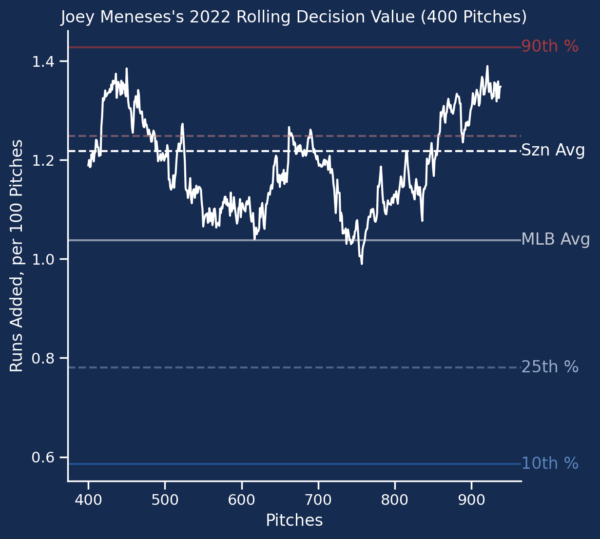
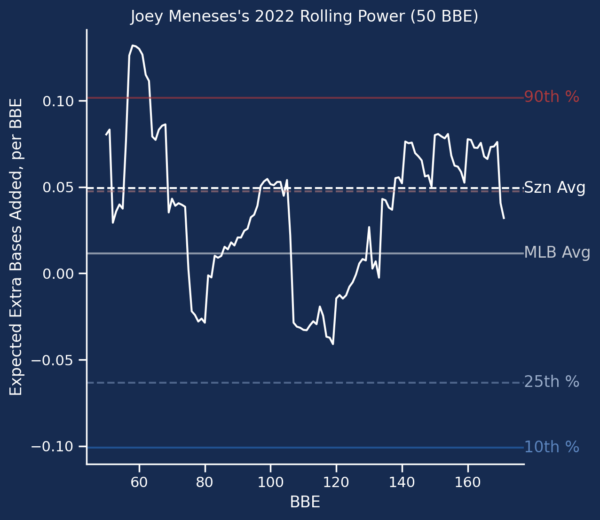
In short, a player with excellent decision-making in the batter’s box with above-average power is a player worth monitoring, and while he’s more likely to wind up as one of your outfielders than your first baseman, there’s more than enough here to consider taking a shot on Meneses late in drafts.
22. Luis Arraez (MIN), 1B/2B/3B
Arraez is one of two players at second base (I’ll get to the other one in a moment) who are frontrunners for the NL batting title. In 1,082 plate appearances since the start of 2021, Arraez has a .307 batting average, which is the third-highest batting average among qualified hitters in that span (only Freddie Freeman and Trea Turner have been better).
Now unlike the two players ahead of him on the batting average leaderboard, Arraez is very unlikely to provide meaningful contributions in power or speed. While he did set a career-high in both home runs and stolen bases in 2021, he did so with just eight home runs and four steals. With Arraez being traded to the Marlins earlier this offseason to be their new leadoff hitter, you can expect Arraez to provide three key contributions to your fantasy squad—runs scored, ratios, and position eligibility at first, second, and third.
Points league players can push Arraez up their boards considerably, as his ability to make contact and avoid strikeouts (he had just a 7.1% strikeout rate last season) is far more useful in that format than in ones that use categories. For the category folks, though, Arraez is more of a niche than a must-roster player. If you have picked up a lot of batting average risk in your draft (guys like Max Muncy, Brandon Lowe, Anthony Rizzo, Adolis García, etc.), Arraez can make a lot of sense as that middle infielder or utility guy who helps balance out those ratios. If you’re already set on ratios, though, you’re best off skipping Arraez as well as the next guy on the list.
23. Alec Bohm (PHI), 1B/3B
Fun fact—Bohm had a higher xwOBACON, or expected wOBA on batted balls, than Alex Bregman. In fact, it wasn’t even close (.383 to .337)! However, because Bohm’s harder contact mostly comes in the form of low-ish line drives, that power presents itself more as a high batting average with low-teens home runs instead of the 25 home run power that Bregman brings to the table.
Like Ke’Bryan Hayes, Bohm was once thought of as a prospect who could unlock power as he developed, but in Bohm’s case, that power just turned into more base hits and not high fly balls, which is good for batting average, but not for providing souvenirs to the folks in the outfield bleachers. Instead, Bohm should be seen as a safe-but-unexciting corner infielder who can likely hit better than .270, and while he won’t contend for a batting title like Arraez, he makes up for it by hitting double-digit home runs, albeit with no speed.
I’d be ready to get more excited about Bohm if he made his way to the top of the Phillies lineup, but with Trea Turner, Kyle Schwarber, Rhys Hoskins, J.T. Realmuto, and Nick Castellanos all likely locked into the top five spots, it’s hard to imagine Bohm getting any extended run as a table-setter while the team is healthy. That role would suit Bohm’s skills much better for fantasy purposes, and if it came to fruition, I’d likely move him ahead of Arraez and Hayes.
24. Lourdes Gurriel Jr. (ARI), 1B/OF
Gurriel Jr. finds himself in a new home in Arizona, and while the supporting cast isn’t nearly as good as the one he left behind in Toronto, at least this new gig comes with a more prominent role in the starting lineup.
Unfortunately, Gurriel Jr.’s barrel rate plummeted in 2022 to a puny 3.8% as he hit just five home runs and stole only three bases in 121 games last season. Sure, it came with a .291 batting average, but I’m not a big enough believer in Gurriel Jr. to expect him to make that kind of profile work in the way it does for Jeff McNeil or Luis Arraez.
While he’s certainly worth looking at as a late-round pick, Gurriel Jr. needs to find a way to get the ball in the air with more authority to ensure more than 4.2% of his flyballs turn into home runs, even if he has to sacrifice batting average to do it. He hit 21 home runs in 2021, so it’s not as though he’s never done it before, though if the power is still absent a few weeks into the season, I won’t hesitate to move on.
25. Jake Cronenworth (SDP), 1B/2B/SS
The power took a significant step back for Cronenworth in 2022 as he hit just 17 home runs and slugged a mere .390 across his 684 plate appearances last season. While Cronenworth did manage to put the ball in the air more often (47.7% fly ball rate in 2022 compared to 36.1% in 2021), he did the opposite of Brandon Drury and pulled just 19.5% of the balls he hit in the air. If you recall from the chart back in Drury’s section, that’s not such a good thing.
Cronenworth could possibly get back to 20 home runs in 2023 if he can just pull the ball a little bit more, and doing so would likely boost his RBI total as he’s shaping up to bat fifth in the top-heavy Padres lineup. Granted, Cronenworth still managed to drive in 88 runners and score 88 times despite the low power thanks to the overall strength of the lineup in San Diego. There’s upside for a top-12 to top-15 season at the position if he can regain some of the power, though if he doesn’t, Cronenworth should still have a reasonably safe floor thanks to the team he plays for and where he’ll hit in the lineup.
26. Josh Naylor (CLE), 1B/OF
In his first sort-of full season, Naylor hit 20 home runs and drove in 79 runners with a .256 average, making him like a two-and-a-half category contributor. While a bit more playing time and health could help Naylor add a few runs scored and home runs to his totals, his high ground ball rate, extreme aggression, and declining strike zone judgment when he’s behind in the count (see below) have me worried that what we saw from Naylor in 2022 is about all there was to see.
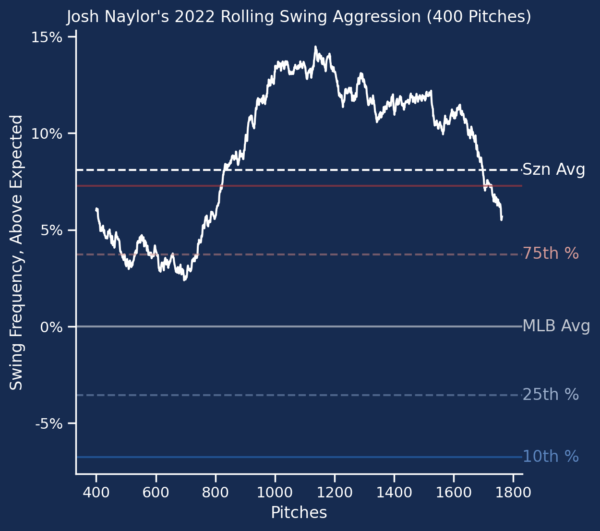
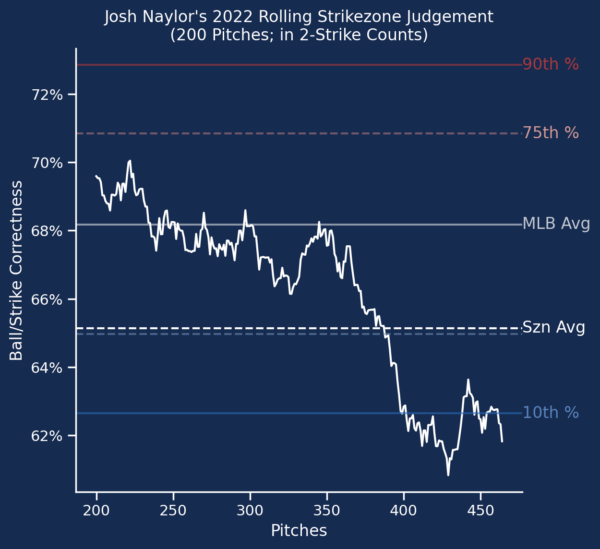
Tier 6
27. Spencer Torkelson (DET), 1B
I’m not an unbiased person when it comes to Torkelson, so I’m just going to drop these here and simply ask that you not give up on him quite yet.
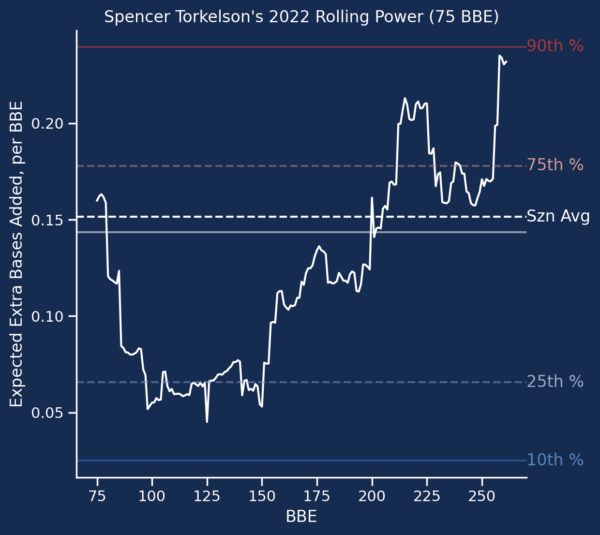
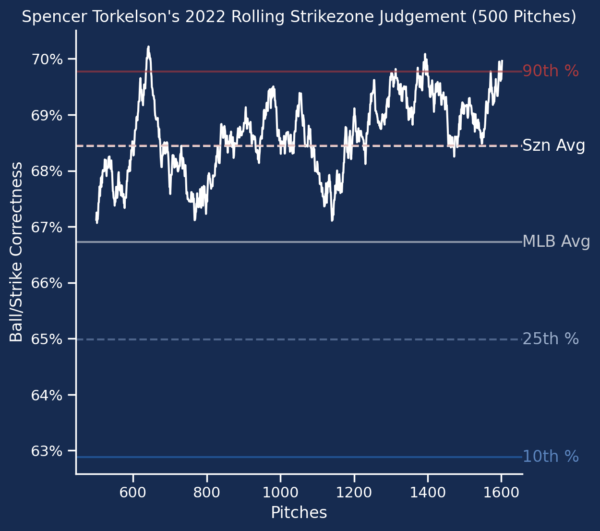
28. Miguel Vargas (LAD), 1B/OF
With a full-time role, Vargas could certainly be a 20-home run, 10-stolen base sort of hitter with a .260-.270 batting average, and with the Dodgers considering him for the second base job, he could pick up key eligibility early in the season.
Of course, the Dodgers still have infield options even after losing both Trea and Justin Turner, and Michael Busch could be called up at any time and take more plate appearances away, so there’s extreme playing time risk here. I like having him on my watch list if I’m doing an early draft, and if I’m drafting closer to the season, my ranking of Vargas is entirely dependent on news related to the position battles in the Dodgers’ camp.
29. Wil Myers (CIN), 1B/OF
Myers hit 17 home runs and stole eight bases in 2021 as a Padre, though he missed a boatload of time in 2022 due to injury. Myers is more of an asset in OBP leagues thanks to his usually double-digit walk rate, though leagues that penalize strikeouts will not particularly appreciate Myers’ near-30% strikeout rate. If you’re in a deep league and need a floor guy late in the draft at corner infield or outfield, Wil Myers is a guy like that. In general, 12-team managers really can look elsewhere.
30. DJ LeMahieu (NYY), 1B/2B/3B
At this point, we can all agree that LeMahieu will not match his career high of 26 home runs in 2023. Based on the evidence we have, it’s safe to say that the power surge was a combination of playing well and the more offense-friendly ball. The more pressing question, and one that is harder to get an answer to, is whether he can go back to being a batting average contributor. LeMahieu’s limited power and lack of speed puts immense pressure on his batting average and counting stats to generate fantasy value, and it just hasn’t been there over the last two seasons.
There isn’t that much upside here, generally speaking, but if LeMahieu can hit .280 or better and climb out of the bottom of the Yankees’ batting order, he could be an interesting source of ratios and runs. If he can’t, LeMahieu isn’t really worth rostering in standard leagues.
Photo by Icon Sportswire | Adapted by Doug Carlin (@Bdougals on Twitter)

Where is the Top catchers list?
It will publish this afternoon! Had to take care of a few things in real life which took longer than I anticipated.
Vinnie P had 28 homers last season, not 18.
This was corrected. Just a typo – the 18 comes from how many he hit in AAA.